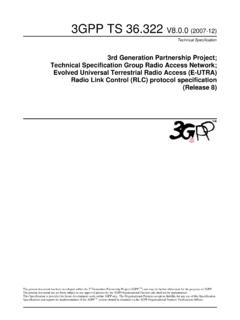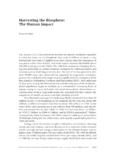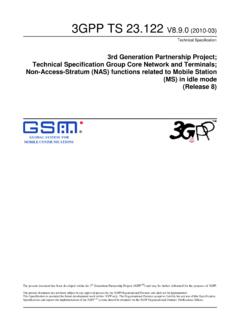Transcription of Stellar Consciousness - Greg Matloff
1 EDGESCIENCE #29 MARCH 2017 / 9stars are cool enough to have stable molecules in their outer layers. Bernard Haisch (2006) speculates that the interaction of vacuum fluctuations with molecular bonds the so-called Casimir Effect is an explanation for how a universal proto- Consciousness field interacts with matter. Could Consciousness enter matter through the Casimir Effect?For Stapledon s concept that Stellar volition contributes to Stellar motions to have scientific validity, and a Casimir-molecular basis of Consciousness to be reasonable, there must be some observable difference in kinematics between molecule-free stars and those with molecules in their outer layers. From spectroscopic observations performed in the 1930s, the spectral signature of simple molecules (CH and CN) is absent in stars slightly hotter than the Sun (in star spectral classes hotter than F8).
2 Hotter stars have atoms in their upper layers. All stars have plasma (ions) in their ClassificationFully expecting to find no support for Stapledon s metaphys-ics, I began to investigate observational studies of Stellar kine-matics. Much to my surprise, I soon uncovered Parenago s Discontinuity, which is named after Pavel Parenago, a promi-nent Soviet-era Russian well as being a very competent astronomer, Parenago was a very wise person. He must have realized that his Stellar observations might cut against the grain of Soviet Materialism and result in a long vacation in a very cold and desolate place. So he successfully protected himself by dedicating a mathemati-cal monograph to the most highly evolved human of all time a fellow named Joseph Stalin!
3 Parenago had discovered that cooler, less massive, redder stars in our Stellar neighborhood revolve around the center of the Milky Way galaxy a bit faster than their hotter, more mas-sive and bluer colleagues. I decided to check this result and soon found some very authoritative sources corroborating Parenago s claim. Parenago s Discontinuity in Local Dwarf and Giant StarsIn preparing my paper for the Stapledon Symposium, I decided In 2011, I was invited to participate in a symposium at the London headquarters of the British Interplanetary Society (BIS). The subject of this one-day event was the contributions of Olaf Stapledon, a British science-fiction author and philos-opher.
4 Stapledon s short masterwork, the 1937-vintage Star Maker is widely cited by scientists and engineers because of his scientific and technological am trained in astronomy, astronautics, and planetary science, but one of my early mentors was Evan Harris Walker, a physicist who is regarded by many to be the founder of the modern science of Consciousness research. He was the first to propose a theory of the nature of Consciousness tied to quan-tum mechanics and based on quantitative physical and neuro-physiological instead of lecturing about Stapledon s predictive contri-butions to astronautics, astronomy, genetic engineering, etc., I decided to examine Stapledon s core metaphysics.
5 Is there any scientific evidence to support Stapleton s opinion that the entire universe is in some sense conscious, and a portion of Stellar motion is volitional? Could stars be conscious?Philosophers have long debated the nature of this elusive quantity, but they have largely failed to even find a definition for Consciousness . Most philosophers who have addressed the hard problem of Consciousness reside in two schools of thought. Those who favor epiphenomenalism are generally of the opinion that Consciousness is an emergent property of brain function: it arises in brains when neural networks become suffi-ciently complex. A competing approach is that of panpsychism: those favoring this view suspect that a field of Consciousness (or proto- Consciousness ) permeates the universe and all matter is, to a certain extent, b eg i n my re s e a rc h e f for t i n pre p a r at ion for t he Stapledon symposium, it was first necessary to consider some means that a universal proto- Consciousness field could interact with a star.
6 Whatever goes on in the Stellar interior, we can be pretty sure that stars do not have neurons. This would seem to rule out Walker s (1970) theory that conscious thought results from elementary particle wave functions tunneling through the electrical potential well between synapses. Stars certainly do not have microtubules, a component of organic cells sug-gested by Lynn Margolis (2001) and Roger Penrose/Stuart Hameroff (2014) to be the seat of Consciousness . But some Gregory L. MatloffStellar Consciousness : Can Panpsychism Emerge as an Observational Science?10 / EDGESCIENCE #29 MARCH 2017to check recent publications on the kinematics of main sequence dwarf stars in our galactic The data come from two sources.
7 The Binney et al. (1997) data points in Figure 2A are from observations of about 6,000 main sequence dwarf stars out to ~260 light years by the European Space Agency (ESA) Hipparcos space observatory. The Gilmore and Zelik (2000) data points are from the 2000 edition of Allen s Astrophysical Quantities, perhaps the most authoritative publication in the field of velocity discontinuity in Fig. 2A is very sharp for both data sets at (B-V) = This correspond closely to the (B-V) color index of F8 stars. The molecular signatures appear in stars of F8 spectral class and cooler ( Matloff , 2011, 2016).Figure 2B is based on Hipparcos data from thousands of giant stars out to >1,000 light years (Branham, 2011).
8 3 Although, as Branham discusses, Parenago s velocity discon-tinuity is evident in this figure, it is not as sharp as in Figure 2A. That is probably because Stellar distance estimates are less accurate for more distant stars and comparison with the refer-ence frame (called the Local Standard of Rest) is less accurate for a larger-diameter European Space Agency Gaia space observatory, a successor to Hipparcos, is now on station. The purpose of this spacecraft is to determine positions and motions of ~1 billion stars in the Milky Way galaxy ( Matloff , 2012, 2015, 2016). But Gaia final results will not be processed and released for a few years. So I have performed a search for other observa-tional results relating to Parenago s Discontinuity.
9 Francis and Anderson (2009) have demonstrated the existence of this phe-nomenon in their analysis of 20,574 stars out to about 1,000 light years. Using a terrestrial 4-meter Schmidt telescope with a 5-degree field of view, Tian et. el (2015) have evaluated the kinematics of about 200,000 F, G, and K stars with helio-centric distances between about 300 and 3,000 light years. Although the error bars seem higher than in the Hipparcos data set, cooler stars with molecules in their upper layers do seem to move more rapidly around the galactic center than hot for Parenago s DiscontinuityScientists develop competing hypotheses to explain various physical phenomena. The concepts that best succeed in explain-ing experimental or observational evidence evolve into suc-cessful theories.
10 Here are some of the competing hypotheses proposed to explain Parenago s possibility, discussed by Bochanski (2008), relate to the fact that all stars begin their lives within dense gas- and dust-filled birth density of stars within these comparatively short-lived galactic structures is much larger than within most of the galaxy. Consequently, low-mass stars might be ejected at higher velocities from the birth nebulae by gravitational inter-actions with other stars than more massive stars. This would certainly result in a higher dispersion in the galactic velocities of a star sample, but it does not explain the systematic velocity The Stellar Community Note that the left vertical axis presents star luminous output relative to the Sun.






